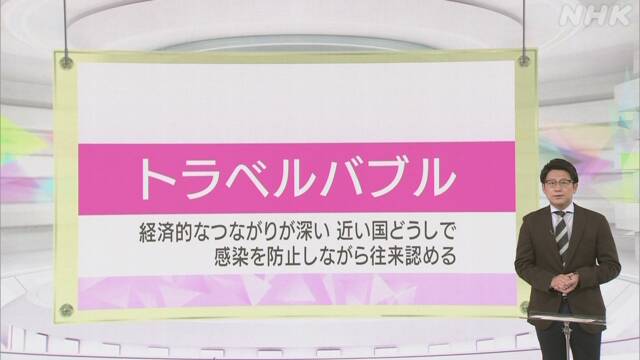Movement to recognize traffic between “neighboring countries” The key to strengthening the inspection system is 7:16 on June 16
k10012471631_202006160700_202006160703.mp4
In regions where the spread of the new coronavirus has become calm, the search is underway to create a framework between countries with close economic ties and to allow each other's traffic while preventing infection. This framework is also called the “travel bubble”, and it is important to prove that the traveler is not infected with the new coronavirus in order to realize it, and strengthening the inspection system is likely to be the key.
The travel bubble is similar to one bubble in the countries that are closely linked economically and socially, and geographically close to each other, where the spread of new coronavirus infection has shown a certain degree of calmness. It is an effort to create a framework and relax the immigration restrictions to allow traffic.
In the world, three Baltic countries, Estonia, Latvia, and Lithuania, have introduced the system since last month, and Australia and New Zealand are also considering the introduction.
Even in Asia, there is a movement to relax immigration restrictions depending on the infection situation and local circumstances, such as establishing a business-only system between China and South Korea.
The Japanese government is also discussing with four countries, Thailand, Vietnam, Australia, and New Zealand, to ease entry restrictions on business people and others.
In principle, countries that have formed a travel bubble will be allowed to enter without taking strict quarantine measures, so it is important to prove that travelers are not infected with the new coronavirus. Strengthening is likely to be the key.
Hawaii: Strong expectations for resumption of traffic with Japan
It is Hawaii, one of the leading tourist destinations in the United States, that strongly encourages Japan to form a travel bubble.
In many mainland US states, the number of confirmed cases per day continues to increase, and Hawaii is forced to be cautious in accepting domestic travelers.
On the other hand, although geographically distant, the number of tourists from Japan is about 1.5 million annually (2018) and the amount of local consumption is about 2 billion dollars (about 210 billion yen) as summarized by the state tourism office. ), it has become an indispensable presence in revitalizing tourism in Hawaii.
According to local newspapers, organizations such as executives of Hawaiian corporations and local lawmakers are willing to prioritize the resumption of traffic to and from Japan.
Crisis management expert "Need system to prove negative"
Masato Takamatsu, a representative of the Tourism Resilience Research Institute, who is familiar with the crisis management of tourism, said, "In the case of Japan, it is easy to control by keeping the airport and port under control. It is very attractive for me," he said, saying that taking thorough measures to prevent infection at the waterfront and resuming traffic with other countries will lead to a recovery in Japan's tourism industry.
In addition, regarding the issue of Japan, "Some countries in the world have already issued negative proof that they are not infected with the virus, but in Japan It is not possible to say, “If you don't establish a system for Japanese people going abroad to prove their negatives, you can't proceed further.” He pointed out that strengthening the inspection system is essential.

